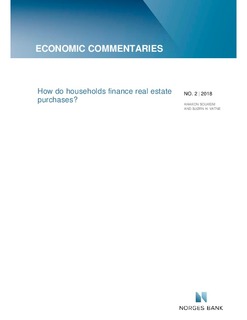| dc.contributor.author | Solheim, Haakon | |
| dc.contributor.author | Vatne, Bjørn Helge | |
| dc.date.accessioned | 2018-12-11T12:11:31Z | |
| dc.date.available | 2018-12-11T12:11:31Z | |
| dc.date.issued | 2018 | |
| dc.identifier.uri | http://hdl.handle.net/11250/2577131 | |
| dc.description.abstract | Norwegian households' high debt levels have long been cited as a financial stability risk (see e.g. Norges Bank's Financial Stability Report). Household borrowing is closely associated with the financing of home purchases, but there are also alternative sources of financing such as proceeds from the sale of a home or household savings. We show how households finance their real estate purchases by dividing buyers into five groups based on age, housing market status and whether they are buying a dwelling or holiday home. We compare financial transactions of real estate buyers with reference groups of non-buyers. As expected, an increase in indebtedness is the most important contribution to financing a home. But these households also draw on bank deposits and other savings. Holiday home buyers rely on savings the most. For first-home buyers, there is an unexplained contribution. This may reflect transfers from parents and receipt of inheritances. | nb_NO |
| dc.language.iso | eng | nb_NO |
| dc.publisher | Norges Bank | nb_NO |
| dc.relation.ispartofseries | Economic Commentaries;2/2018 | |
| dc.rights | Attribution-NonCommercial-NoDerivatives 4.0 Internasjonal | * |
| dc.rights.uri | http://creativecommons.org/licenses/by-nc-nd/4.0/deed.no | * |
| dc.title | How Do Households Finance Real Estate Purchases? | nb_NO |
| dc.type | Others | nb_NO |
| dc.description.version | publishedVersion | nb_NO |
| dc.subject.nsi | VDP::Samfunnsvitenskap: 200::Økonomi: 210::Samfunnsøkonomi: 212 | nb_NO |
| dc.source.pagenumber | 13 | nb_NO |

